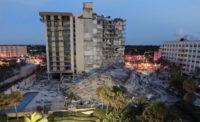Last month, more than 1,100 lb of strategically placed explosives brought down the 24,000-ton, 455-ft-tall cooling tower at the U.S. Dept. of Energy’s Savannah River site in Aiken, S.C., the second largest such structure to be imploded, says the firm.
“The implosion surpassed everyone’s expectations,” says Doug Loizeaux, vice president of Controlled Demolition Inc. (CDI), Phoenix, Md. The firm was the explosives preparation and performance subcontractor to American Demolition and Nuclear Decommissioning, Grand Island, N.Y., which received the approximately $4-million contract to implode the former nuclear-site cooling tower and remove debris. The latter task will be handled by LVI Services Inc., New York City.
A 10-person CDI demolition crew spent 45 days preparing the structure, loading more than 1,100 lb of explosives into 3,860 holes drilled in its support legs at ground level and around the midsection. The tower’s 8-in.-thick walls expanded to 36 in. at its 330-ft-dia base. The charges detonated in a controlled fashion with precise sequencing. “We worked 250 ft off the ground from a crane and blasted two and a half weeks early,” Loizeaux says.
The tower was built in the early 1990s to provide water to cool a 1950s-era nuclear reactor that was built for activities related to nuclear weapons production, but it was never used. DOE announced it would phase out all uranium processing in 1992, when the tower was finished.
The site’s reactor was shut down in 1996 and converted to a storage facility four years later. There was no contamination at the demolition site. The implosion was part of a $1.6-billion sitewide “footprint reduction” initiative funded by the American Recovery and Reinvestment Act.
CDI says it successfully imploded a cooling tower in 2006 at a decommissioned nuclear powerplant site in Oregon that was 499 ft tall and weighed 42,000 tons.



Post a comment to this article
Report Abusive Comment